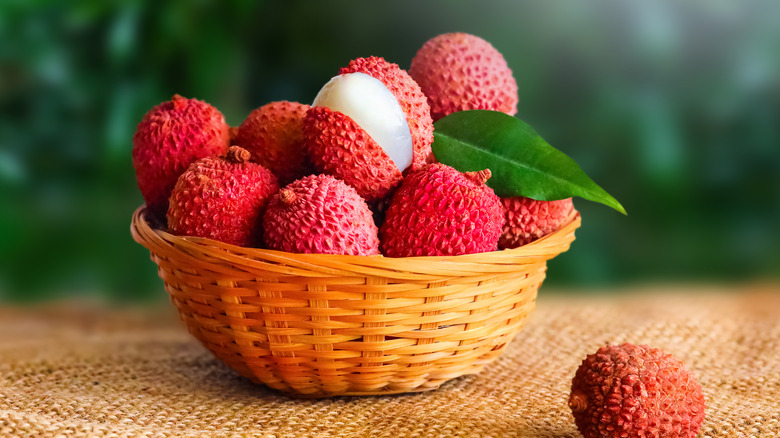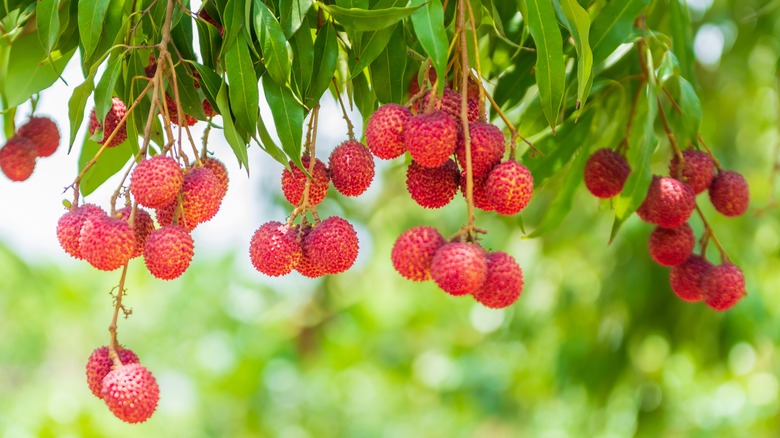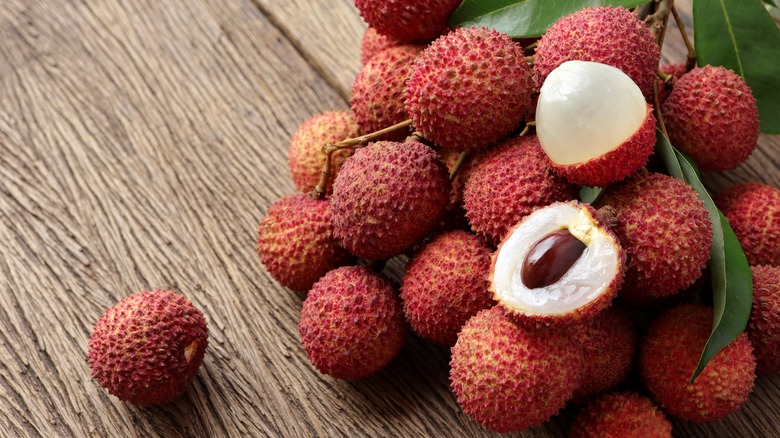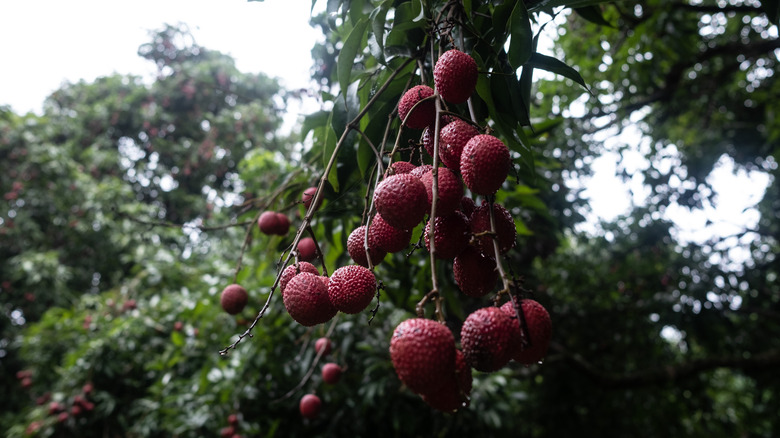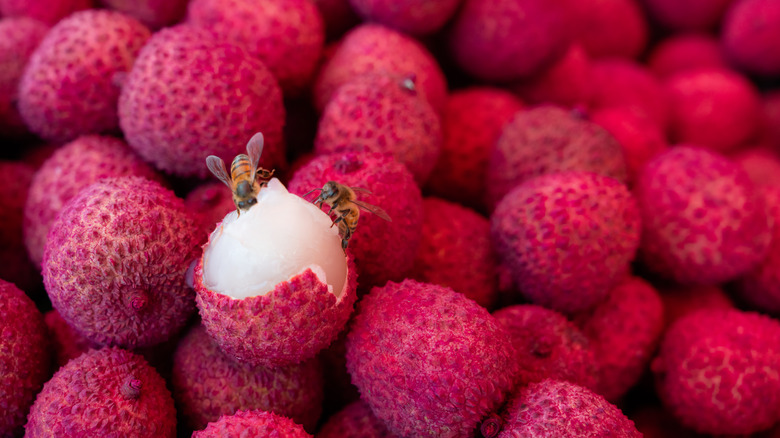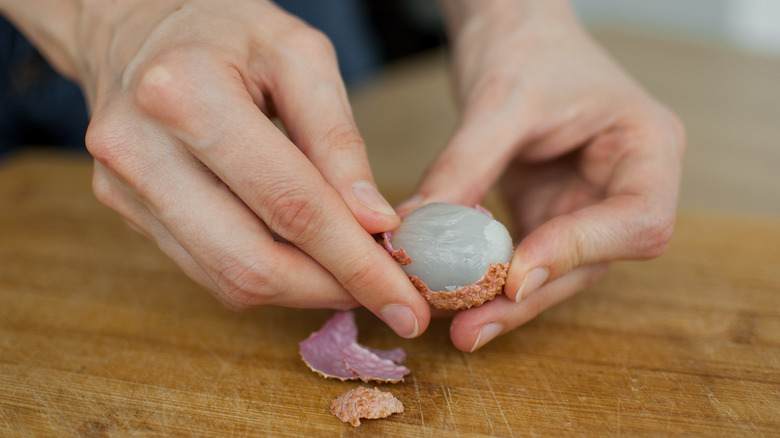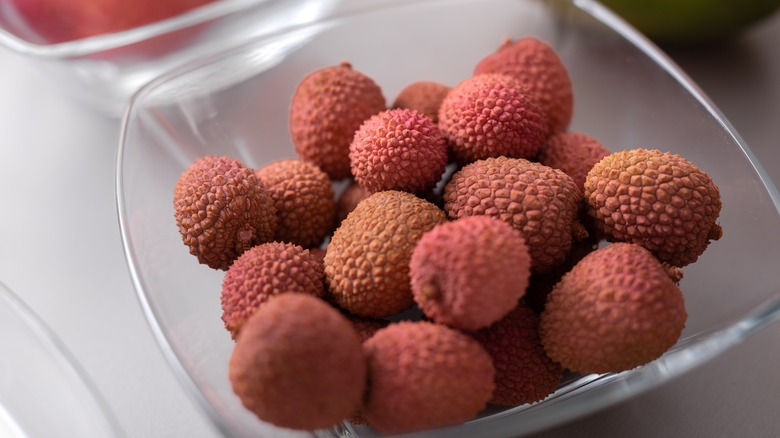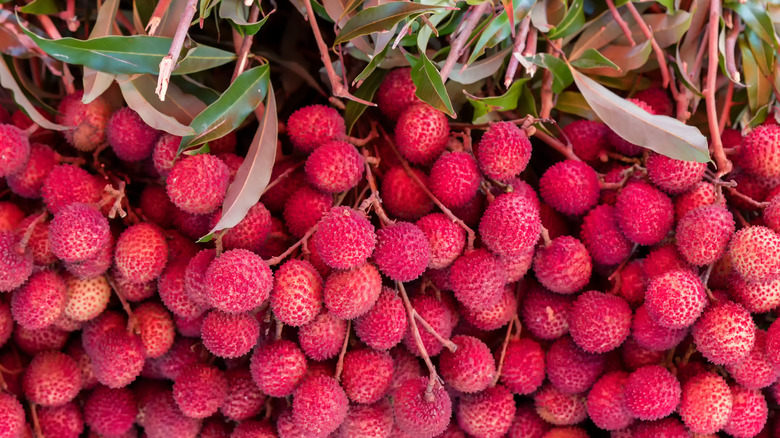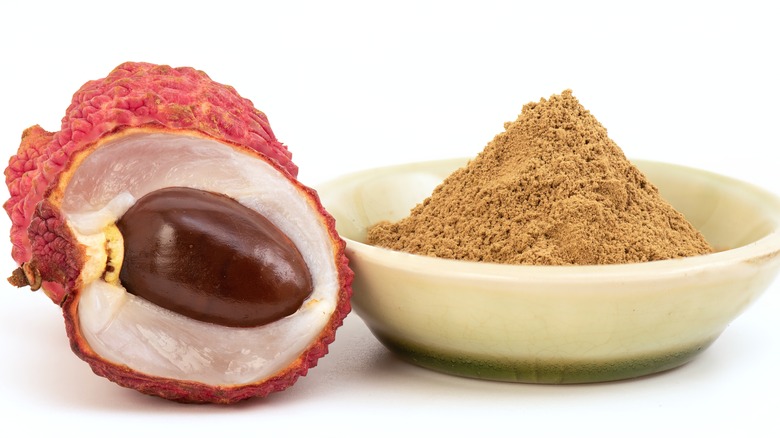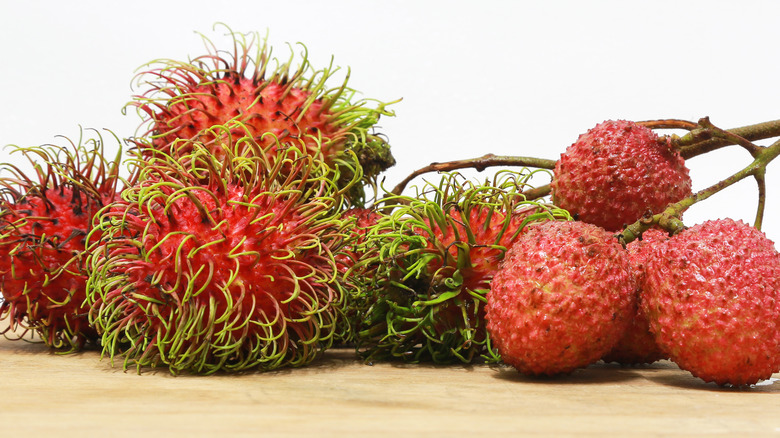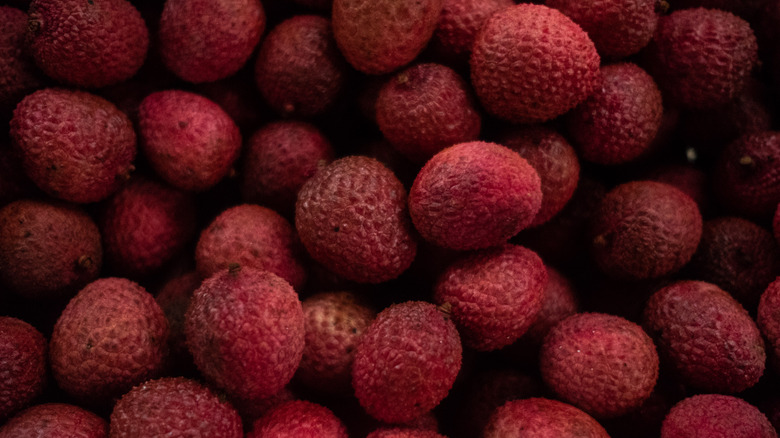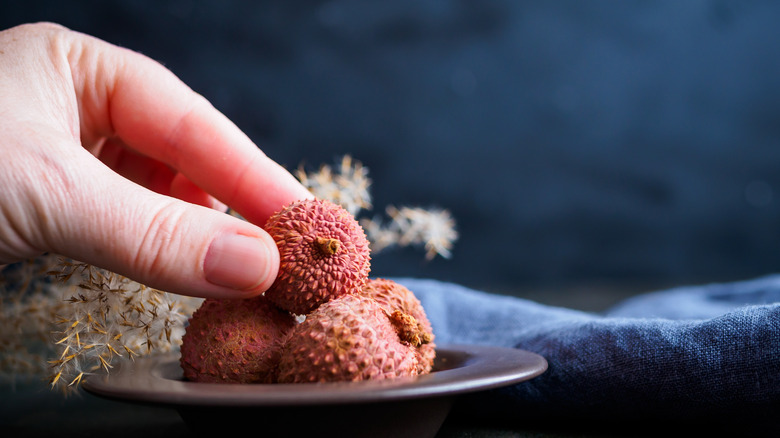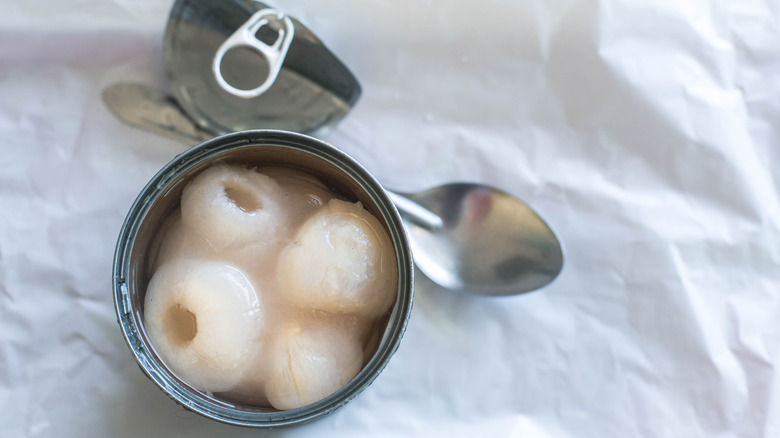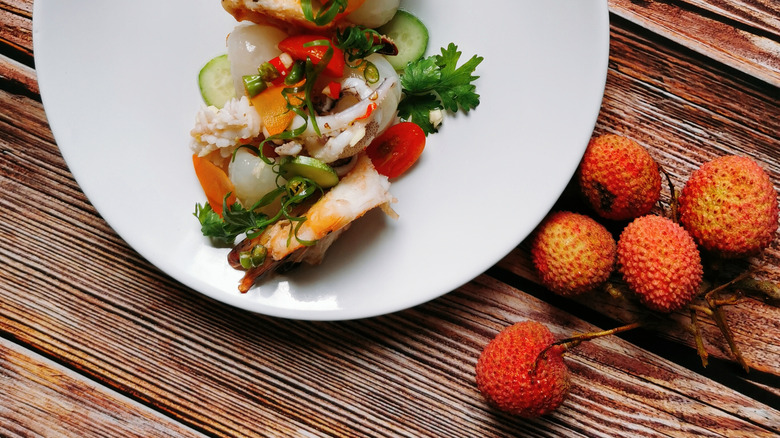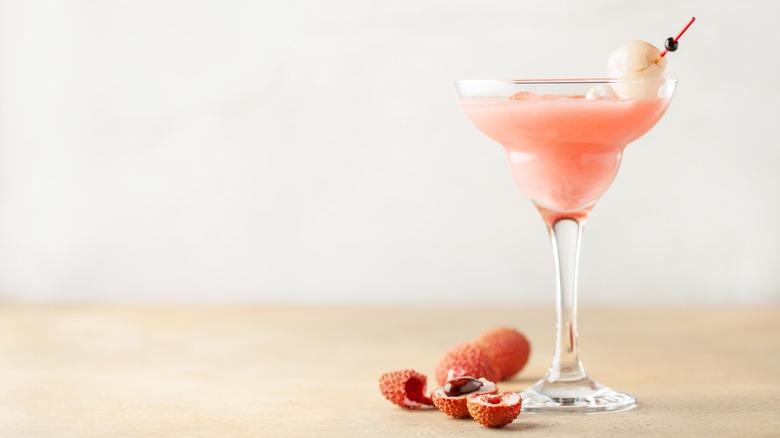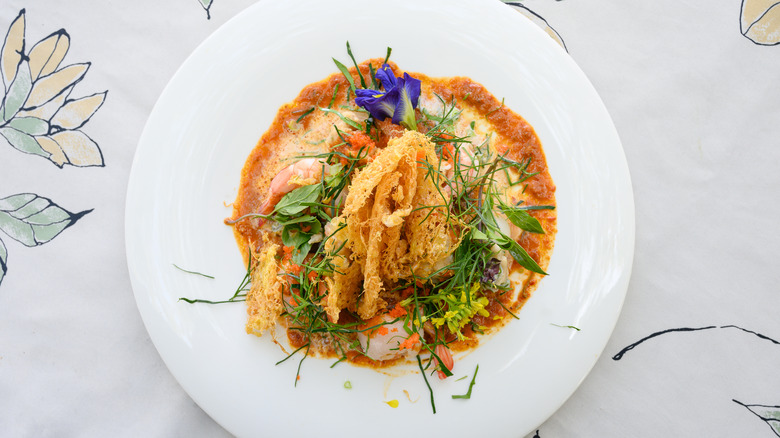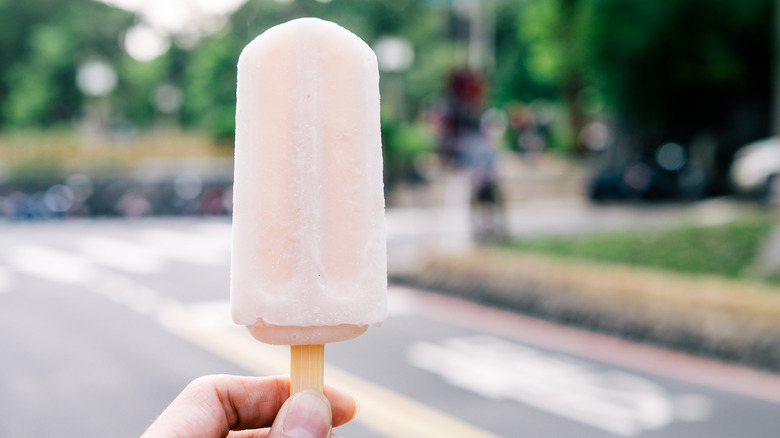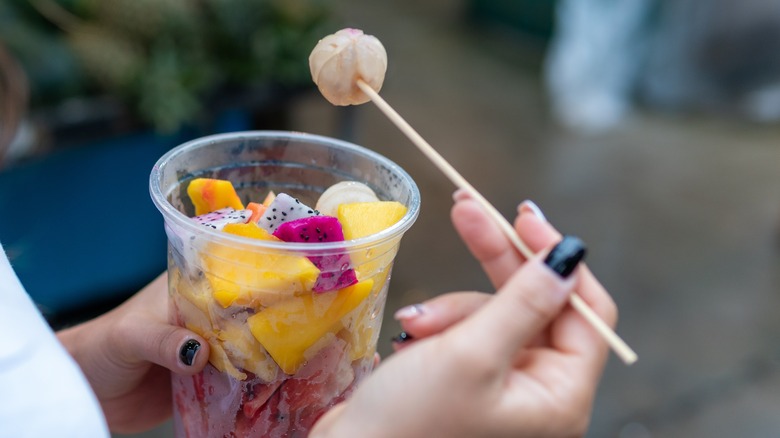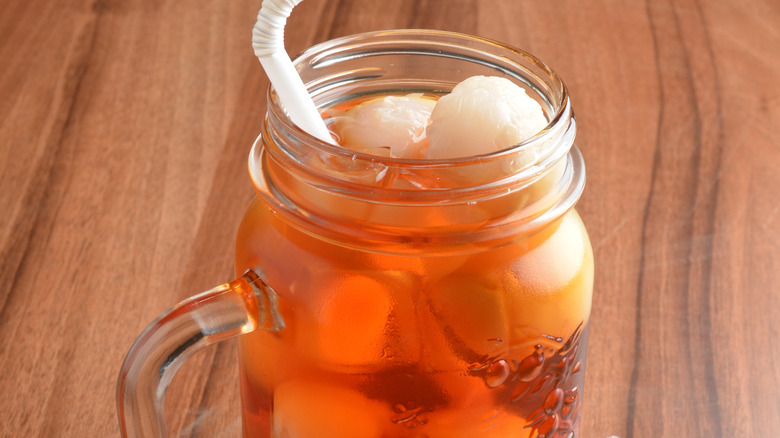Everything You Need To Know About Lychee Fruit
We may receive a commission on purchases made from links.
Satisfy your inner child and go grab some alligator strawberries, or if you're a little older at heart, lychees — or if you're a little more scientific at heart, Litchi chinensis. These bright little fruits are a sweet treat alone and a wonderfully complex ingredient to make use of with others.
Their pinkish-red durable peel hides scotch-white juicy flesh, which itself surrounds a waxy long brown pit. Lychee (pronounced "lie-chee" or "lee-chee") is noted for not only its taste and versatility, but for its aesthetic; the ruby fruit is certainly memorable with its textured covering. According to American botanist Walter T. Swingle, the very first published work documenting the different varieties of lychee dates back over some 1,200 years to 11th-century China (via The Lychee Biotechnology).
Spelled lychee, litchi, or lichi, this fruit has found its way all around the world, featuring in both savory and sweet dishes; and as its popularity grows, so, too, do the amount of questions about it. So let's dig a little deeper and uncover what we can of these little red rubies.
Origins and history of lychee cultivation
Originating in Southeast Asia, and now with farms all around subtropical Asia, Africa, and the Americas, lychee has grown from a local delicacy into an internationally commodified cash crop. According to Britannica, lychee holds local importance to many regions in and around Asia, particularly certain parts of India and China. Cantonese culture is particularly noted for making use of lychee since ancient times in food, drink, and even some types of medicine.
Notably and most widely grown in China and India, the earliest records of lychee cultivation date back to the 11th century in the southern regions of China, Malaysia, and the northern regions of Vietnam. Some historians believe unofficial records refer to lychee as far back as 2,000 years ago, to the Han Dynasty.
The first recorded appearance of lychee in the Western world was through trade routes in Jamaica in 1775, and the first instance of successful lychee cultivation in the U.S. occurred in the early 1900s in Florida, where the fruit has become an important commercial crop.
Lychee is a drupe
Although lychee fruit may look like round, hard-shelled strawberries they actually come from the soapberry family, along with their more flamboyant-looking cousins, rambutans. Lychee fruit is categorized as a drupe, which is also known as stone fruit. Stone fruits get their name from having one large pit at the center, resembling a small stone, instead of tiny edible seeds like most fruit. Familiar stone fruits include peaches, cherries, apricots, and even cashews (yes, these are a fruit). Stone fruits are known for their fleshy interiors and honey-like sweet flavoring. And in these departments, lychee does not disappoint.
Although we often see just a few varieties grown in the U.S. there are dozens of variations including the No Mai Tsze, which is crispier on the inside and well-loved among lychee fanatics. Other notable varieties include Maritius, Hak Ip's smaller pit, Seymor, and Garnet.
Each variety varies ever so slightly in appearance, some having more prominent bumpy skin, while others have a more oblong shape. In addition, their flavors are slightly distinctive, like those of apple varieties. Some are tarter while others are milder and sweet with stronger floral notes.
Lychee trees grow in the United States
Lychee fruit was first cultivated in Southern Asia, but don't let that discourage you from trying to find some in your area. Today, lychee is grown in the U.S. in warmer climate states like Southern Florida, California, Hawaii, and Texas. This is because these evergreen trees are subtropical and cannot tolerate cold snaps. This means that even if you live in a state where the sun doesn't shine, you may still be able to get your hands on these little red nuggets imported from the vacation states.
Because the climate in the United States varies from that of Southern Asia, only a few varieties of lychee trees have been consistently successful. These varieties include the Brewster and Mauritius lychee which you may be able to find in stores like Whole Foods Market or Trader Joe's, both of which carry the fruit in select locations. If you're fresh out of luck there, you can always make your way over to an Asian market or look in the produce section of your local grocery store.
Where to buy lychee fruit
If you're looking for fresh, rich lychee fruit, you'll need to wait until the summer — usually about May to September in the U.S. As recently as 2014, outlets such as ABC News were reporting you could only buy lychee in Asian supermarkets. Luckily, that's no longer true.
The fruit is becoming increasingly available at many national U.S. chains. Recently, this summer fruit has officially arrived at Trader Joe's and other specialty shops, which regularly offer it alongside other warm weather produce. And if fresh lychee hasn't reached your local grocery yet, you can find it through local farms or Amazon. Additionally, canned or dried ("nut") versions are available year-round.
It's essential that you know what to look for when buying lychee. Pick ripe fruit since they don't ripen once plucked from the tree. Also, too many underripe lychees can be dangerous to eat because they have higher levels of toxins before they're fully ripe. So, what do ripe lychees look and smell like? The fruit should have a floral scent and should be brightly colored. They should be bigger than 1 inch and give a tiny bit when you pinch them. Don't buy the lychees if they are split or oozing.
What lychees taste like
Lychee has been described as tasting like something between a strawberry and a watermelon with some delicate floral notes. Its consistency is somewhat between that of a dense grape and a ripe plum. Its very juicy flesh and pleasantly sweet flavors are a favorite as dessert and fruit salad toppings and many Asian recipes will feature lychee as a natural sweetener.
There is also quite a variety of lychee strains; each with their own unique characteristics, but all are still sweet and delicious. Some of the more popular varieties of lychee include kaimana and emperor. There are some with more flesh and smaller pits, some significantly larger, some with more concentrated flavors, and some better suited for cooking and others for drinking. Assuming you are in a region with suitable conditions, or your thumb is green enough, you can even purchase lychee trees to plant and grow lychees yourself.
Its bumpy skin is not edible
While it's incredibly convenient to chomp right into a peach, pear, or apple, which is self-contained in edible wrapping (its own skin), lychee fruit doesn't have such convenience. Instead, you can think of it like an orange or banana. Yes, you have to peel away the outer layer, but the inside is uber-protected from damage, chemicals, and bacteria. Luckily, the shell isn't very appealing anyway and can be described as looking like a tough, round, bumpy ball.
Although the shell looks rather intimidating to crack into, you can simply remove it by peeling it away with your fingers. Start by pulling out where the stem meets the fruit, and chip away from there. Unlike a banana or clementine, the outer layer is likely to crack into pieces, so try to open it over a surface to catch all the little bits that fall off. You can also open it by using a sharp knife and making a shallow incision around the circumference. Then, pull it apart to remove the outer shell. Don't forget about the pit in the middle! We can assure you that your teeth would lose that battle.
How to store lychees
Just as with most other fruits, lychees should be left out to ripen and refrigerated to keep fresh. Per Pantry Tips, lychees left at room temperature will expire after two to three days, but in the fridge, they can last up to a week (to be safe, five days). You can also freeze lychee fruit, and this, according to the website, will preserve them for six months.
Generally there is no consensus on what temperature to eat your lychees, so whether enjoying them fresh and frosty out of the fridge or slow and sweet at room temperature just make sure to really relish them. A grocery bag full of them in the fridge or a bowl of them left out always seems to vanish quickly.
Buying canned or dried lychee is also a great alternative to buying them fresh as they can be used as different ingredients that take a little less preparation, have some different flavor profiles, and have a much longer shelf life.
Nutritional benefits of lychee
The lychee fruit (or pulp) may be delicious but the seeds or pits should not be consumed, as they contain certain chemical compounds that in large doses and in unhealthy bodies can be damaging. A 2014 study, published in the peer-reviewed journal The Lancet, linked large amounts of lychee consumption in malnourished children in India and Vietnam with encephalopathy, resulting in symptoms like seizures and loss in some brain functions. It is worth noting that these were niche cases in malnourished children and normal lychee consumption in healthy children and adults is completely safe.
Nutritionally, lychees actually provide many of the same health benefits as fruits such as strawberries and blueberries. According to Harvard Health, daily servings of fruits and vegetables have been found to drastically reduce risks of death from various health issues, meaning eating lychee is not only a tasty treat but could prove a lifesaving survival strategy. WebMD, meanwhile, states that lychees are high in antioxidants and vitamin C — essential nutrients for a healthy body; so no matter who you are at heart, grabbing some little alligator strawberries will help it pump a little cleaner.
Who shouldn't eat lychee fruit
Lychee fruit is delicious and generally nutritious, but that doesn't mean it's suitable for everyone. Researchers at Humboldt University in Berlin and University Hospital in Zürich found that people with latex or sunflower seed allergies may be more prone to have adverse reactions, such as anaphylaxis, when consuming or even touching lychees. That's because all of these items contain high levels of a protein known as profilin, which triggers an allergic reaction.
Additionally, lychee fruit has been found to lower blood sugar, which could be beneficial in managing diabetes (via China Academy of Chinese Medical Sciences and Beijing University of Chinese Medicine). However, if people with diabetes are already on medicine to lower their blood sugar, they might need to be careful about how much lychee they consume. More research is being done on the topic. For now, it's important to talk with your doctor and decide together whether lychee fruit is right for you.
Lychee vs. rambutan
Lychee and rambutan are related — they're in the same botanical family, Sapindaceae. So it can be difficult to tell them apart, especially once the fruit has been peeled. Even still, lychee and rambutan are different, with some very key separations between the two fruits. Rambutans (Nephelium lappaceum) are bigger than lychees (Litchi chinensis), but probably the most significant difference is the spiky-looking hair covering the rambutan. Rambutans sort of resembles little Koosh balls or sea anemones.
Rambutan and lychee are both high in vitamin C and should be peeled before you enjoy them. As with lychee, you don't want to eat the rambutan seeds. Regarding taste, rambutans are creamier and don't have the same floral flavor lychees do. But, you can eat the flesh the way you would eat lychees. They are different fruits for all their similarities, and they both deserve a spot on your table.
Lychee vs. longan fruit
From the outside, lychee and longan fruit couldn't be more different. While lychee dons red bumpy skin, longan fruit is green and smooth. Once peeled, both fruits look similar, and actually share some similarities in flavor as well. Lychee fruit has milkier flesh and the fruits are larger than longan, but both have a fleshy, chewy texture and a dangerous center pit. Longans are more durable than lychee because their skin is tougher, which helps to preserve freshness once picked.
Although the two fruits are similar, and grow in the same climates, lychee fruit tends to outshine longan because of its sweeter flavor and more succulent taste. Because they are both part of the soapberry family, it's no wonder the two are often confused or swapped out in recipes. What you need to know about tropical longan fruit is that they are much more difficult to find outside of their native lands. That means that it's likely you'll only have the opportunity to try lychee unless you're an avid traveler or get lucky; although, there are limited longan trees growing in warmer climates in the United States.
Choose ripe lychee
The intensity of sweetness and flavor of fruit entirely depends on when it's picked, and when it's consumed during the ripening process. Ever bite into an underripe mango or banana and question why anyone would each such a tart fruit? Well, the same goes for lychee, so it's important to choose ripe fruit, especially if it's your first time eating them. We wouldn't want the experience to leave a bad taste in your mouth, after all.
Once picked, lychee fruit can remain fresh for up to 30 days if kept refrigerated, but its bright red color tends to fade around day 10. This gives suppliers plenty of time to ship it all over the country for consumers. In the U.S., you'll likely find ripe lychee in stores between August and November, as this is when they tend to reach maturity and are ready for harvest. Ripe lychee can be identified by its bright red skin. If you're seeing spots of green, then it's likely the fruit was picked prematurely. In fact, you should run for the hills because unripe lychee can be dangerous by causing extremely low blood sugar if consumed.
Eat lychee during flu season
As we all know, fruit is often loaded with healthy nutrients that help with day-to-day bodily functions. This is why your mother told you to eat your fruits and veggies, and why an apple a day keeps the doctor away. Lychee is no exception to the rule and is a nutrient-dense food filled to the brim with healthy benefits.
Quality of Life explains that you should be adding lychee to your diet because it is an incredible immunity booster thanks to high levels of vitamin C. In fact, just one serving contains more than your daily requirement of the nutrient. In addition, lychee can aid in digestion and help with weight loss. One major benefit of eating lychee fruit is that it can help to lower blood sugar, according to Quality of Life, but this also means that those who are diabetic and already on medication to do so should talk to their doctor before consuming the fruit. For everyone else, it's time to stock up on the little drupes, especially this flu season.
It's not necessary to buy lychee fresh
Although we can't always get our hands on fresh, tropical, and unique fruit, that doesn't mean you have to give up your hopes of tasting lychee fruit altogether. And while fresh is usually best when it comes to trying a new food for the first time, we're making an exception.
Canned lychee can often be found in the Asian section of the grocery store or at any South Asian market. Because lychee holds its form beautifully, the texture of canned or fresh lychee doesn't vary terribly. It's often in heavy lychee syrup, which can be used on its own in a number of ways. In fact, lychee syrup is quite desirable and has a sweet, honey-like flavor. It can be used to sweeten teas, over baked goods, alongside fruit, or even drizzled over ice cream.
Really, lychee syrup can be used as a sweetener in any recipe and won't overpower the original flavorings. Consider buying canned lychee to take advantage of not only the dense, fruity pearls of fruit but of the sticky sweet syrup as well.
Know what to eat it with
Classically, fruit is enjoyed as a breakfast or dessert. It's often served alongside a dairy product like yogurt or ice cream and can be sweetened with additional syrups and sauces. Lychee, however, is quite versatile and can make an easy appearance in your breakfast, lunch, dinner, or dessert. In fact, lychee pairs quite pleasantly with white meats and seafood.
Consider grilling the stone fruit alongside the white protein of choice before incorporating the two into a meal. Use soaked skewers so the fruit doesn't fall to its fiery doom. You can even layer the fruit on a skewer with vegetables and chunks of protein. Although there are many ways to eat lychee, we recommend leaving the fruit whole or halved alongside the main part of the dish, after it's been pitted of course. Experiment with recipes like lychee lime shrimp, sweet and sour pork with lychee, or lychee and coriander snapper.
Get boozy with lychee
Although you may not be entirely prepared to pair lychee fruit with meat, there's one thing for sure that goes well with just about any fruit, and that's booze. Consider making lychee cocktails when lychees come into season or use canned lychee to make floral-sweet drinks all year round. They can be frozen and blended into tropical cocktails, or used as a garnish in anything from martinis to gimlets. Use the syrup from canned lychee to sweeten drinks of any kind, whether it's the featured flavor or not.
If you're new to the fruit, try a classic lychee martini and keep things simple with lychee syrup, vodka, gin, and ice. For your spooky Halloween party, use lychee stuffed with blueberries and dabbed with red dye in your cauldron of drinks. Lychee already resembles the white part of an eyeball, so you might as well lean into it and give your guests a fright.
Pair with seafood
Because lychee fruit has floral and subtly sweet notes, it's no wonder that it pairs beautifully with prawns, white fish, and other seafood. In fact, the chewy white fruit almost resembles a creature of the sea and even has a similar sweetness to that of cooked scallops. And while you may be familiar with pineapple and shrimp tacos or ceviche with watermelon, we argue that lychee complements deep sea critters in a unique and tantalizing way that should become a fine-dining favorite.
Unlike many fruits, lychee is rather chewy, and its flavor, although sweet and understated, leaves room for the subtle flavors of even a white fish to shine. Consider a recipe like Hawaiian pa'i'ai with lychee, ho'io and dried shrimp straight from an island that lychee calls home. Lychee syrup should also be considered when creating any seafood recipe that calls for a sweetener. In addition, lychee fruit can be skewered with a more robust fish before being tossed on the grill and drenched with citrus juice like lime, and fragrant spices.
Make lychee syrup
Now that we have you reading all about lychee syrup, you may be itching to get your hands on some. But if you've opted for fresh fruit, don't fear, you can make your own and don't need to rely on the canned version. Simply bring a pot of water with granulated sugar to a boil. Once it's going, add peeled and pitted lychee fruit and let it simmer. As it cooks, the lychee will release juice, and infuse the sugar water with flavor. Boil the water down until it reaches a syrupy consistency, then pour it into a jar to cool. You can leave the lychee fruit in the jar for further infusion, but remove it before serving. Keep the liquid for up to a week in your refrigerator.
Drink lychee syrup by making a non-alcoholic fizz, boozy cocktail, sweetened iced tea, or homemade lemonade. It's thick enough to drizzle over pancakes and waffles, or even add to your sundae bar over ice cream or sorbet. Lychee syrup can be used in place of any sweetener, so let your culinary creativity run wild.
Freeze tropical popsicles
When summertime hits, there's nothing better than a frozen popsicle to refresh your overheated body. And while everyone loves a strawberry or chocolate pop, it's fun to explore new options and whip up a batch of something unique. Instead, try making lychee-cycles.
Simply blend shelled and pitted lychee fruit with enough water to reach a liquid consistency. Pour it into your popsicle molds and let your freezer do the rest. If you'd rather enjoy a creamy pop, then consider adding coconut milk to the blender instead of water for a silky smooth outcome. In fact, blended lychee is a great way to sweeten coconut milk without the use of refined sugar.
Go tropical and blend lychee with pineapple, coconut, lime juice, and any of your other favorite vacation fruits to bring your tastebuds on a little trip. Lastly, lean into the stone fruit vision and pair blended lychee with cherries, peaches, and apricots. Be sure to leave little chunks of fruit in the popsicle molds.
Add to fruit salad
Most people can agree, there's nothing worse than a fruit salad with mushy fruits like bananas mucking up the consistency. Even worse, oxidizing apples without the balance of citrus to keep them looking fresh can be a huge culinary no-no. Luckily, there is one fruit that is not only unique but also holds its form well and doesn't go brown quickly. You guessed it, lychee fruit to the rescue.
When picking out fruit salad ingredients you should consider a variety of components. Texture, visuals, and balance of flavor are all important. Because lychee is light-colored, it tends to absorb the juice from other fruits and become almost tie-dyed, which can be quite beautiful. It's chewy enough to hold its own, and won't break down, even if cut up into pieces. Lastly, its light floral sweetness pairs with any fruit, and although it won't be the dominating flavor in the bowl, it will give your taste buds a pleasant break from any tart or overpowering fruits. Pair with tropical or stone fruits for beautiful visuals, and especially complementary flavors.
Enjoy lychee tea
Tea enthusiasts gather around. There's a new flavor that can be incorporated into your tea-drinking rituals in a variety of ways. The easiest way to make lychee tea is to boil fresh or canned lychee in water and strain it before enjoying the hot beverage. This is a mellow and subtle beverage that can be enjoyed by people of all ages as it's caffeine-free.
Another approach is to boil lychee with jasmine tea or to sweeten jasmine tea with lychee syrup. Either tactic gives you a beautiful pairing that can be flavored with rose, lemon, or ginger. Flavored lychee tea can be purchased at retailers or online, which is an especially good option if you're having trouble sourcing the fruit. Enjoy lychee tea hot or iced, either way, the flavor is sure to captivate your tastebuds and leave your friends and family wondering what unique flavoring you used for such a honey-sweet tea with floral undertones.
